Explore the latest news and find out what's on this month
Explore our learning offer for schools, families and community groups
Uncover the rich history of Elmbridge with our latest online exhibitions
Want to discover more about your local area?
Explore the latest news and find out what's on this month
Explore our learning offer for schools, families and community groups
Uncover the rich history of Elmbridge with our latest online exhibitions
Want to discover more about your local area?
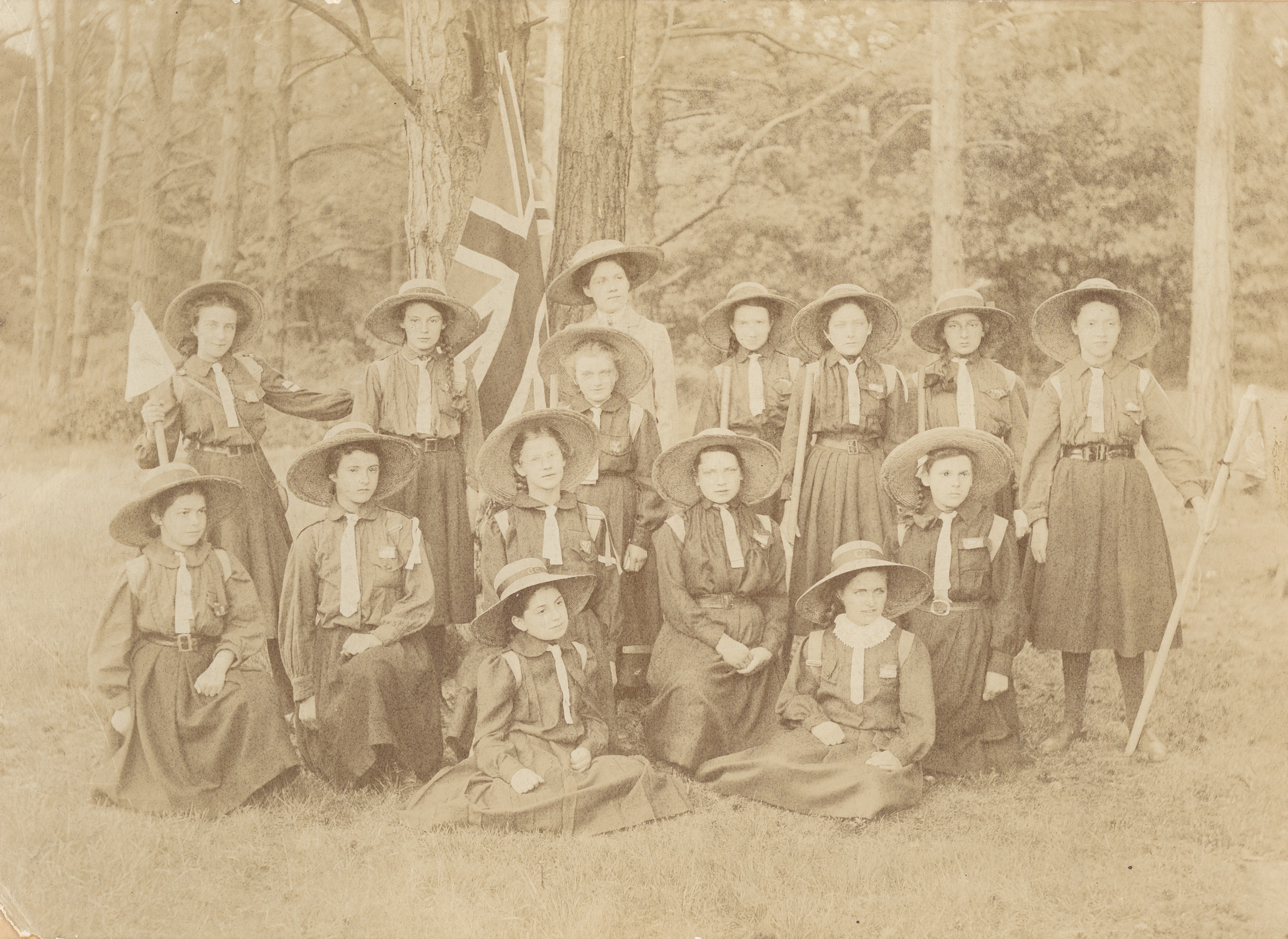 The 1st Weybridge Girl Guides, 1910, at Brooklands Estate. The group of girl guides are seated and standing in possibly the grounds of Brooklands House. The Union Jack is held by Miss James (Captain).
The 1st Weybridge Girl Guides, 1910, at Brooklands Estate. The group of girl guides are seated and standing in possibly the grounds of Brooklands House. The Union Jack is held by Miss James (Captain).
2014 saw the centenary of the Brownie Guides, and an exhibition was launched by Elmbridge Museum at Esher Civic Centre to mark the occasion. This online exhibition follows on from the exhibition, by taking a closer look at what being a Brownie has meant over the years.
The Girl Guides Association started as an offshoot of the Boy Scouts, founded in 1907 by Robert Baden-Powell. In 1909, girls gate-crashed the first Boy Scout Rally at Crystal Palace. They attracted Baden-Powell’s attention and asked him to offer something for girls too. Baden-Powell’s sister Agnes formed the Girl Guides in 1910 and a junior section for under 11s was created the following year.
The organisation has always aimed for girls’ personal and social development, focusing on the individual, their community and the world.
Through meetings, day trips, camps and holidays, Brownies have, for over a hundred years, learned new skills, explored other cultures and had outdoor adventures. Today, Girlguiding is the leading charity for girls and young women in the UK. The items you can see here either come from Elmbridge Museum’s collection or were kindly loaned by the 2nd Hinchley Wood Brownie Unit.
Girlguiding Mission
All Brownies have to make a Promise that expresses the core values of the organisation and is the common standard that brings them together.
The wording of the Brownie Promise has altered a dozen times over the last century, with the most recent (and most controversial) change being to remove any mention of God. Making and keeping the Promise is the heart of what it is to be a Brownie.
“I promise that I will do my best, to be true to myself and develop my beliefs, to serve the Queen and my community, to help other people and to keep the Brownie Guide Law.”
Click each of the tabs on the left to expand them.
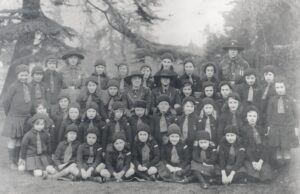
The 1st Walton St. Mary’s Brownies, 1922.
The second part of the Brownie Promise is to ‘serve the Queen’ (or King).
This is explained to girls as meaning that they can serve the Queen by trying to help our country and the people in it. They should help everyone they can, starting at home, then reaching further out into their communities and the wider world.
The concepts were explained simply to young Brownies in the 1990s, through cartoons and values guides.
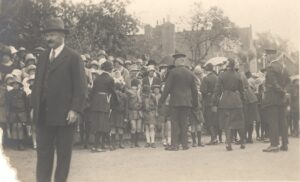
Postcard showing a crowd lining the street for the opening of Weybridge Hospital by Princess Beatrice, 27th June 1928. There is a row of Brownies at the front of crowd. This is one such event for the Brownies which would have been seen as ‘serving the King’ and the country.
The third part of the Brownie Promise is to keep the Brownie Guide Law:
“A Brownie Guide thinks of others before herself and does a good turn every day.”
Brownies are encouraged to think of it as starting at home, and it is acknowledged up front in their handbook that it can be very hard for them to do. This Brownie Magazine is from 1979 and shows a group of Brownies helping another girl who has fallen over. It would have been a good example of keeping the Brownie Law to all of its young readers.
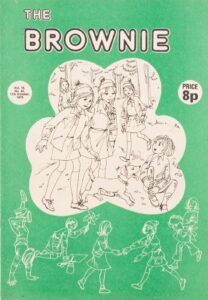
‘The Brownie Magazine’ in paperback, Vol. 18. No 42, 17th October 1979. Originally priced at 8p.
The promise badge is given to girls, along with a certificate, when they make their Brownie Promise. Girls learn the importance of the Brownie Promise before they make it.
A whole Pack takes part in the ceremony to welcome new Brownies. Joanne Marychurch, a former Museum Assistant Learning Officer, recalls having to jump over a ‘stream’, look in a mirror, and repeat a mantra from the Brownie story ‘Twist me and turn me and show me the elf, I looked in the water and there saw myself’ at her Promise Ceremony in the 1990s.
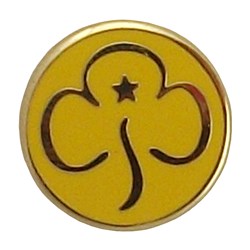
A Brownie Badge, loaned by the 2nd Hinchley Wood Brownie Unit.
Since 1968, Brownies have been encouraged to think of themselves as on a footpath, or journey, with a series of challenges along the way, all of them being ways of carrying out their Promise.
There are eight challenges, shown on this page from 1987. Brownies can earn Interest badges to help them learn more about challenges. Once they have completed all the challenges, a Brownie will probably be ready to move on to the Guides.
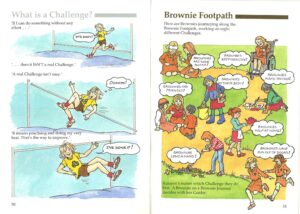
Pages from a Brownie handbook outlining the ‘Brownie Footpath’. It shows examples of the eight different types of ‘challenges’ Brownies are expected to undertake on their journey.
A brownie scarf in yellow cotton, c.1970. Made up on a band to button at the back of the neck. It carries a brownie badge in white metal showing a small figure super-imposed on the Girl Guides trefoil shape. Donated by the 1st Thames Ditton Brownie pack. When the Brownie uniform changed in 1950, the tie changed from brown to yellow.
Knitted woollen Brownie hat, c.1970. Donated by the 1st Thames Ditton Brownie pack. The woolly hat was brought into the Brownie uniform in 1950, replacing the brown beret.
Brown Brownie belt with Association stamp, purchased in 1964.
Brownie's brown woolen beret, dating back to c.1960s. The Brownie uniform changed in 1950, which is when the woolly hat was brought in to replace the beret. In reality, girls wore a mixture of the old and new uniform in the 1950s after the change had been made.
Buttoned brown shirt and yellow cotton triangular scarf, part of the brownie uniform (c.1960s).
Girl Guides Ranger's uniform consisting of a long-sleeved blue dress with badges, and a lanyard. Originally from the 1st Cobham Rangers c.1930s.
A girl guide uniform from 1957. The tunic has blue flashes, 1st. Walton-on-Thames (St. Mary's) tabs, and a Surrey Lion badge on the left shoulder. There are wings and a cornflower patrol badge above the left pocket. There are also Laundry and Fire Lighting badged on the sleeve.

The Brownie Adventure is divided into three areas: you, your community and the world. Here we look at the latter two. Girls are encouraged to become active citizens by helping them understand and be active in their communities, for example by raising money for charities or visiting local places of interest. Brownies also learn about the wider world through Thinking Day and various activities. They might celebrate a festival from a different culture, find out about endangered animal species, or learn how they can combat climate change.
Drag the timeline or click the round dots to flick through it.
The Baden-Powells (founders of the Guides and Brownies) are shown together on this postcard. It was sent to the 1st Long Ditton Guides in 1940 from the 4th Gidea Park Guiding Pack to celebrate Thinking Day.
Gidea Park is in East London. Thinking Day is a special day for Guides and Brownies to think about their international sisters, and also about their founders. It was introduced in 1926 and is marked on 22nd February, the birthday of both Robert and Olave Baden-Powell.
This photograph shows an original handwritten account of the 1951 Remembrance Day dedication ceremony at the Memorial Garden in Hinchley Wood.
The facing page has a lovely account of the 1st Hinchley Wood Girl Guides joining a meeting of the 1st Hinchley Wood Brownies to welcome one of the Brownies up to the Guides. The Brownie, Edith Tregaskes, was 'presented with her wings' after which she 'flew-up' to the Guides.
Long Ditton Brownies gather for festivities on Giggs Hill Green, Thames Ditton, in January 1954.
The Brownie uniform had changed in 1950, although this photograph shows how girls wore both old and new styles at this time. The hat changed from a beret to a woolen cap and both are in evidence here. The tie also changed from brown to yellow. A girl to the right of the picture is also wearing the 1934-50 brown tie.
From the 1950s until 1972, Brownies, Guides, Cubs and Scouts shared what was known as 'The Hut' on Lynwood Road, Thames Ditton. This was a much-loved ex-army hut, reputed to have started its life during the First World War on Salisbury Plain.
The Hut was demolished in 1972 and 'Lynwood', the present Joint Headquarters, was opened on the same site in 1974. This is a photograph of the opening ceremony.
The top of this page from the 3rd Hinchley Wood Brownies' Log Book for 1975 records girls collecting money over Easter to buy bottles of fruit juice and a few small eggs to give to the old people at St Chads. Each Six also made an Easter card for them.
Further down the page there is a record of an "Xmas Good Turn: Made box of crackers containing sweets and novelties for children from a local children's home."
Brownie Revels are occasions when Brownies get together with girls from other Packs for games, activities and fun. This photograph marks Brownie Revels in 1979 at the Lynwood Road recreation ground, Thames Ditton.
This 1991 Thinking Day order of service is from the Dittons District. The service was held on a Sunday, 2 days after Thinking Day, for the Rainbows, Brownies, Guides and Rangers at St. Christopher's Church in Hinchley Wood.
Today, with 10 million members from 146 countries, the World Association of Girl Guides and Girl Scouts is the largest voluntary movement for girls and young women in the world. On World Thinking Day, girls are encouraged to think of themselves as 'one in ten million' and to reflect on the potential for change that a movement of these numbers can inspire.
Brownies develop self-confidence and self-esteem by having new experiences and learning new skills. They build friendships and learn to share and cooperate with others by working together in small groups called 'Sixes'. Girlguiding seeks to promote six areas of girls' development: spiritual, social, emotional, physical, moral and intellectual. Brownies can extend their knowledge and abilities by working towards Brownie interest badges. Subjects cover anything from Science investigator to Circus skills.
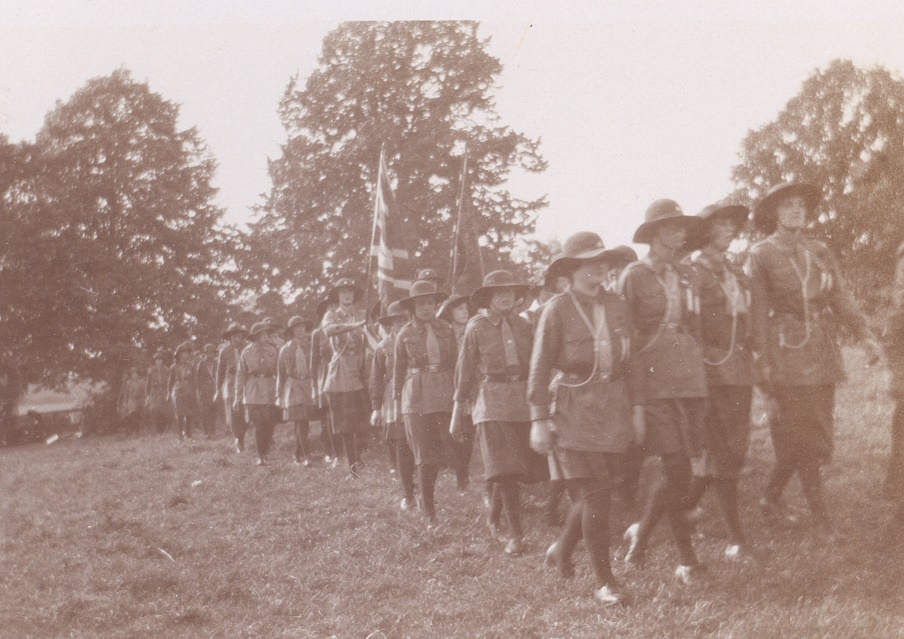 girls from the Walton Girl Guides hiking with the Union Jack at camp in 1928.
girls from the Walton Girl Guides hiking with the Union Jack at camp in 1928.
“We took a bus to Dorking and then walked up to Ramone Common. When we reached the top we ate our sandwiches and, after a short rest, had a strenuous game of rounders. Then we walked down to Effingham and caught the bus home. It was a lovely sunny day and although we were very tired when we got home, we had all enjoyed our first hike together.” From Hinchley Wood Brownies and Guides log book, April 1947.
Hiking has been a regular activity for Guides and Brownies over the years since the groups were founded. The photograph opposite shows girls from the Walton Girl Guides hiking with the Union Jack at camp in 1928.
This doll was knitted by a Brownie from the 1st Hinchley Wood Brownie Pack, probably to earn their Knitter Badge. The Knitter Badge from the 1968 Handbook has the following instructions:
1. Choose your own pattern and, following the printed directions, make a garment using at least two different stitches.
2. Make something else of your own choice: mittens with thumbs, a bobble hat, a set of three fancy mats or something similar.
Drag the page or click ‘next’ and ‘previous’ to flick through the pages.
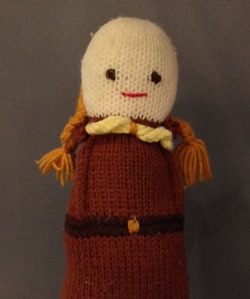 A doll depicting a Brownie Guide knitted by a Brownie from the 1st Hinchley Wood Brownie Pack, probably to earn their Knitter Badge.
A doll depicting a Brownie Guide knitted by a Brownie from the 1st Hinchley Wood Brownie Pack, probably to earn their Knitter Badge. 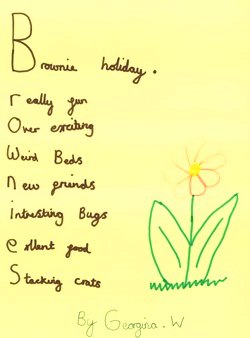 Georgina, a Brownie from the 2nd Hinchley Wood Unit, made this poster especially for this 2014 exhibition. It describes all the things that she enjoyed about her recent Brownie holiday.
Georgina, a Brownie from the 2nd Hinchley Wood Unit, made this poster especially for this 2014 exhibition. It describes all the things that she enjoyed about her recent Brownie holiday.
Georgina, a Brownie from the 2nd Hinchley Wood Unit, made this poster especially for this 2014 exhibition. It describes all the things that she enjoyed about her recent Brownie holiday.
Holidays and camping trips have from the very early days been part of the Brownie experience – a way for girls to develop self-confidence, independence, learn new skills and have great fun with their friends.
To earn their Handywoman Badge, Brownies in 1951 had to pass a series of eight tests:
1) Work a sewing machine.
2) Replace a gas mantle or electric bulb.
3) Turn off the gas, electricity and water at the mains.
4) Clean and repaint a table, door or window.
5) Clean paintbrushes.
6) Mend three of a choice of items.
7) Sharpen a knife on a grindstone.
8) Do four of a choice of DIY tasks including staining a floor.
Times have changed!
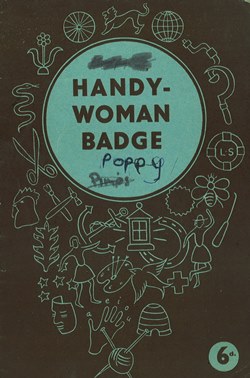 To earn their Handywoman Badge, Brownies in 1951 had to pass a series of eight tests, from DIY skills to home maintenance and domestic skills such as sewing.
To earn their Handywoman Badge, Brownies in 1951 had to pass a series of eight tests, from DIY skills to home maintenance and domestic skills such as sewing. 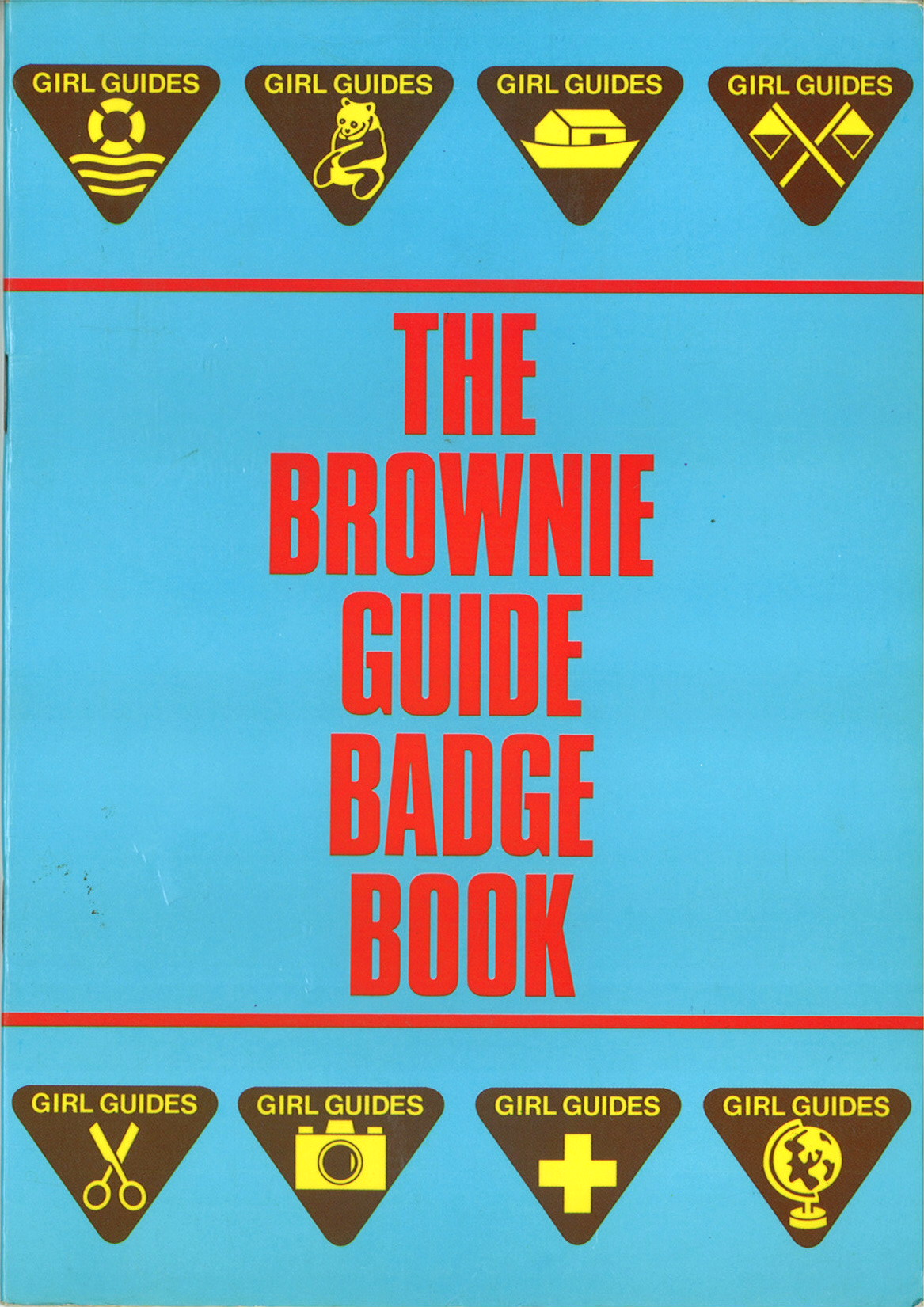 This 1987 badge book told girls what they needed to do for each of the badges they could work on as a Brownie.
This 1987 badge book told girls what they needed to do for each of the badges they could work on as a Brownie.
This 1987 badge book told girls what they needed to do for each of the badges they could work on as a Brownie.
Subjects included: Art, Conservation, Cooking, Crime prevention, Dancing, Hostessing and Toymaking.
There is an interesting mix of old and new, with a Computer badge asking girls to write a “simple 10-20 line program and run it” as well as a Signalling badge requiring them to learn semaphore or Morse code.
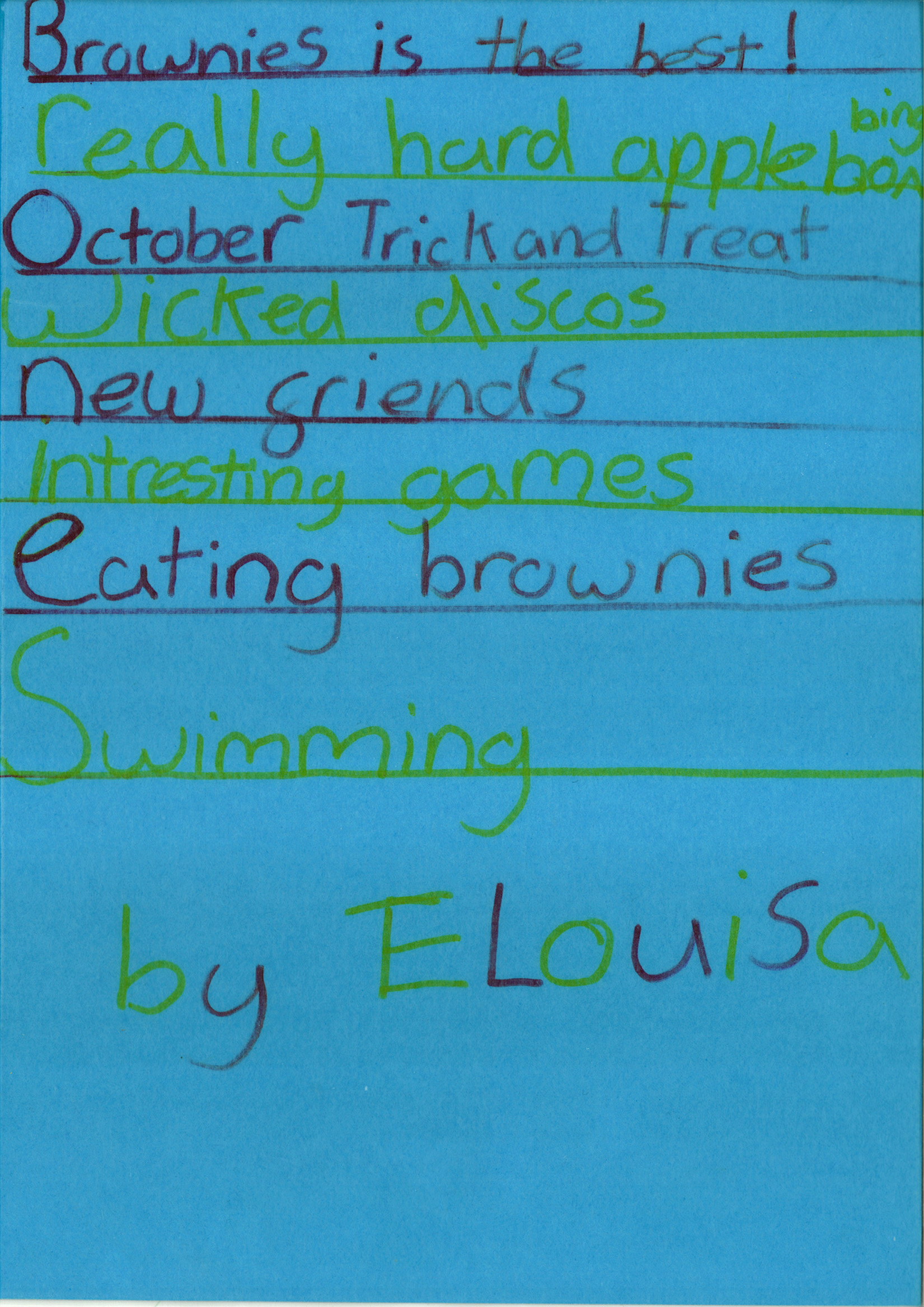 This poem on life in the Brownie Guides talks about many of the different activities and crafts the Brownies regularly do. It was written by Elouisa of the 2nd Hinchley Wood Unit.
This poem on life in the Brownie Guides talks about many of the different activities and crafts the Brownies regularly do. It was written by Elouisa of the 2nd Hinchley Wood Unit.
This poem on life in the Brownie Guides talks about many of the different activities and crafts the Brownies regularly do, with the beginning letters of each line spelling out the word ‘Brownie’. It was written by Elouisa of the 2nd Hinchley Wood Unit.
“Brownies is the best!
Really hard apple-bobbing,
October trick and treat,
Wicked discos,
New friends,
Interesting games
Eating brownies,
Swimming.”
This page from the 1995 Brownie Guide handbook shows how the organisation moved with the times. Girls learn how drugs, solvents, alcohol and cigarettes damage their body. The information on this page is very factual and informative. It doesn’t shy away from telling girls that people do get some short-term benefits from using certain substances (they ‘feel happy’) as well as damaging their health.
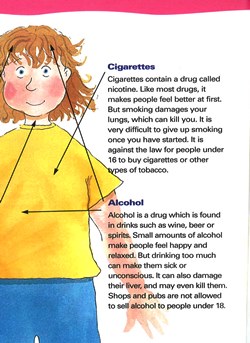
Elmbridge Museum regularly collaborates with local children's groups and schools to put their creative work on display. Why not discover more artwork from local youngsters in our exhibition to celebrate 75 years since V.E Day with St. Charles Borromeo Primary School?
See the V.E Day exhibition hereDiscover more about the Scouts by taking a closer look at some of these handy links
More information on the Brownies on the Girlguiding website See some amazing images of the Girl Guides over the last 100 years in this article celebrating their centenary A brief history of the Girl Guides and Brownies for kids
Leave a Comment
We always love to hear your feedback. Let us know your thoughts in the comment section here!You need to be logged in to comment.
Go to login / register